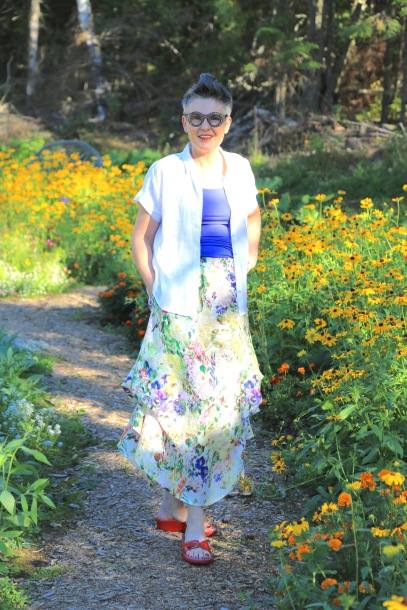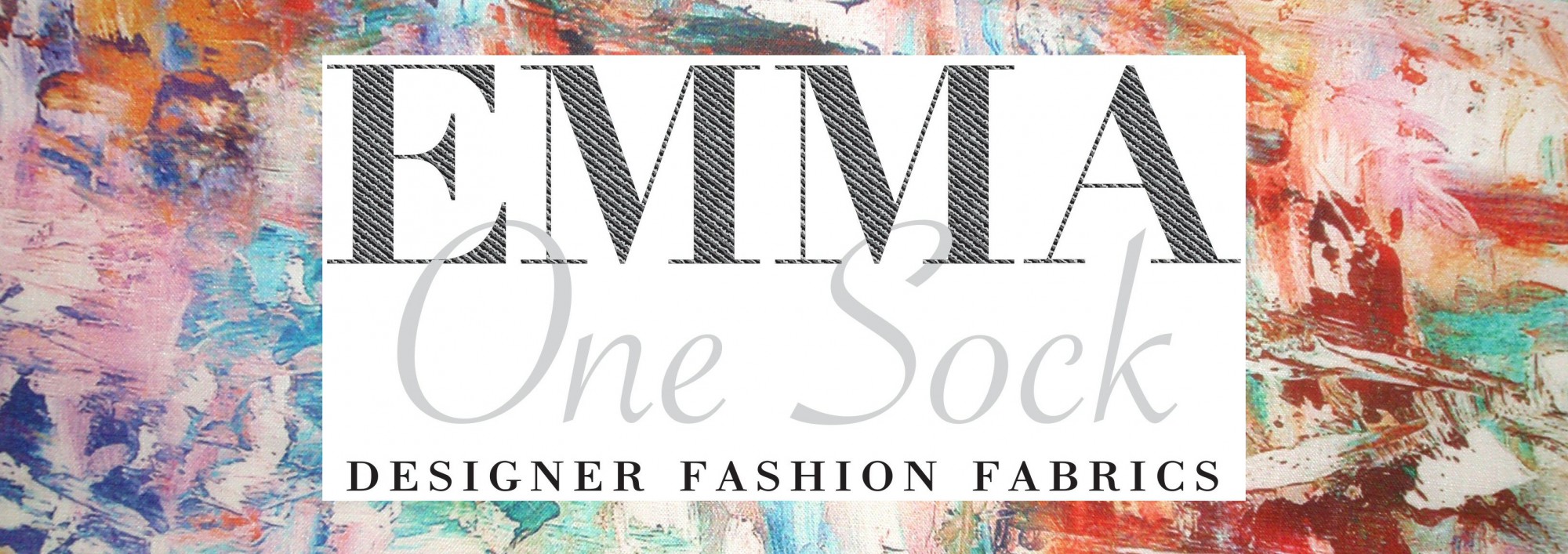by Kathryn Brenne
To see a list of all sewing tutorials, click here!
With botanical prints being so popular this season, it is easy to see why this
EOS linen print is a best seller! This beautiful watercolor floral print was perfect for
Vogue 9114. Linen has the right amount of crispness to hold its shape but falls easily into the draped folds of the skirt which are created with ties underneath the skirt.



Kathryn Brenne strolling through her garden
The skirt pattern as I developed it has a minimal amount of ease in the elastic waist, to avoid excess bulk at the top of the skirt. The waistband is just large enough to fit over the hips, but for those who prefer more of an opening, I include here a technique for adding an invisible zipper to the side seam which does not interfere with the elastic running through the waistband. Also for this version I have added a side seam pocket, using a technique that is easy adaptable to any pattern or ready to wear garment. A narrow seam allowance is all that is required! No pocket extension is needed, and the finished pocket is flat and invisible.
Fabric
Linen is a great warm weather fabric. It is cool to the touch and breathes. Dry cleaning is often recommended but I tested a large sample by putting it in the washing machine and dryer. It came out perfectly, softened slightly and did not lose any of its color. If you wish to machine wash and dry your garment test a large sample first to be sure you like the results.

Kathryn again!
The flower print on this fabric is such that it can be oriented in either direction, making it perfect for
Vogue 9114, which is cut with the lengthwise grain running horizontally across the finished skirt. When laying out the pattern I tried to avoid placing a large round motif on the center of the bum or in the middle of the crotch area.

Skirt untied and the print running across the garment
Seams and Finishing
To create a nice, neat finish, this linen can be serged or zig-zagged around the cut edges of each pattern piece, before you begin assembling your garment. Please note though, that when preparing the edges and also when sewing your skirt together, you should use directional stitching, meaning that you should sew from the widest to the narrowest point of each pattern piece. In other words, sew from the hem towards the waist for the skirt side seams. This prevents the fabric from being stretched as you sew on the slightly bias edge.
Adding a Pocket to any Seam Allowance
Vogue 9114 comes with a pocket pattern for the pants, but this pattern can be used in the skirt as well. This handy technique requires no extra seam allowance or extension to add a pocket bag to any garment. The Back Pocket Bag has a 5/8” seam allowance on the side seam. Cut the Back Pocket Bag from self fabric. The Front Pocket Bag has a 1/4″ seam allowance on the side seam. Cut the Front Pocket Bag from lining. If you wish to draft your own pocket pattern to use this technique on another garment, the important thing to remember is make the Back Pocket seam allowance 3/8″ wider than the Front Pocket seam allowance.

Fuse a 1” strip of
featherweight fusible interfacing to the skirt Front and Back pocket area. Pink the edge of the interfacing that sits into the garment. The interfacing should extend 1” beyond the end of the pocket.
Stitch the Back Pocket Bag to the garment with a 5/8” seam allowance. The stitching should be positioned at the pocket opening, which is approximately 5 1/2 – 6” long.
Stitch the Front Pocket Bag to the garment with a 1/4” seam allowance.
Press Front Pocket Bag away from the garment and edgestitch.
Join the Front and Back garment sections together above and below the pocket opening.
Press seam open and edge stitch front pocket opening.
Sew around the pocket bag.
Baste top of pocket bag to skirt Front.
Adding an Invisible Zipper and Waistband with Elastic
Apply a 1” strip of
lightweight fusible interfacing to the upper 9” of the left skirt Front and Back side seam. Pink the edge of the interfacing, which sits into the garment.
When sewing the left side seam of the skirt stop stitching 8 5/8” from the waist. Insert an 8” invisible zipper into the opening, placing the top stopper of the zipper 3/4” down from the waist edge.By placing the stopper slightly below the 5/8” seam allowance, there is enough space for the slider to close fully. The slider sits slightly above the stopper when closed. The waistband needs a small extension added to one end to accommodate a skirt/pant hook and bar, which is sewn to the finished left back waistband. The seam for the original waistband, which was placed at center back will now be at the side seam. Add 1 1/2” to the left back waistband.
Press the waistband in half wrong sides together. Attach one edge of the waistband to the skirt, leaving the extension on the skirt left Back. Press seam towards the waistband. Cut two lengths of 1/2” wide elastic to fit your personal waist measurement. Place the ends of the elastic in the seam allowance of the skirt Front waistband.
Sew across and then zig zag the ends of the elastic to the seam allowance of the waistband.
Now that the elastic is attached to the seam allowance, move it out of the way by folding it away from the skirt. Turn under the 5/8” on the unnotched edge of the waistband. Trim pressed edge to 3/8” to reduce bulk. Turn waistband to inside along pressed fold line. Baste pressed under edge of waistband to the seam of the skirt. Edge stitch close to the seam from the right side of the skirt. Stop edge stitching 1” short of the skirt Front zipper area. Leave long thread tails, pull through to the wrong side of the garment, tie off and bury inside of the waistband.
To form the casing, stitch waistband along stitching line. Stitching will begin above the Back zipper and stop 1”short of skirt Front zipper. Tie off thread tails as before.
Thread the two pieces of elastic through the casing. They have already been anchored to the Front seam allowance. Since the edge stitching and casing stitching stopped 1” short of the Front zipper, it is easy to thread the elastic back into the casing and have the 5/8” seam allowance fold back into the casing. To secure the elastic, stitch across ends on the waistband Back. The stitching will come straight up from the Back zipper.
Pull the elastic tight after the ends have been stitched and cut. The cut ends will disappear inside the waistband. Fold the raw edges of the skirt Back waistband to the inside and edge stitch the opening closed.
Finish stitching the open 1” which was left on the skirt Front waistband. Complete the edge stitching and topstitching leaving long thread tails, which can be finished as before. Edge stitch the open ends of the casing closed.
Finish the waistband with a skirt/pant hook and bar. I use 3 strands of embroidery floss and a buttonhole stitch to sew on the hook and bar.
Bias Ties to Tie up Draped Skirt
The ties for the skirt are cut on the bias and sewn right sides together with 1/4”seam allowance.
Lightly press the seam allowance open.
Sew across one end of the tie.
Use a chopstick or other such tool to turn the tie right side out.
Tie turned right side out with seam running down the center:
Note from Linda: To see more linen prints that would work for this beautiful skirt, click here!































Would You tell Me, where did You get this beautyfull hook?
LikeLiked by 1 person
I particularly like the technique for installing a pocket on any garment! I love any techniques that one can apply generally– Having these tricks “in my pocket” (ha ha) helps me to feel more confident and free to create rather than to be so tied to individual pattern instructions! Thank you Kathryn.
LikeLike
Your projects look wonderful!
LikeLiked by 1 person